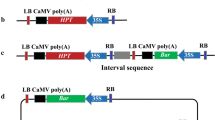Summary
Hypocotyl explants of threeBrassica napus varieties were infected with two nopaline typeAgrobacterium strains each carrying a distinct disarmed T-DNA containing different selectable markers. Selection was done for only one of the markers, after which the regenerated plants were screened for the presence of the second marker. High co-transformation frequencies of both T-DNA's were obtained (39%–85% of the transformants). Where the two T-DNA's were integrated linked, they were usually present in an inverted orientation relative to each other; in all of the cases observed the two right borders were adjacent. Tandem orientations occurred less frequently. The T-DNA's were mainly integrated as intact copies and deletions did not often occur. The co-transformation system described favors a genetically linked integration of the two T-DNA's (78%), although in a single transformed plant both linked and unlinked copies of both T-DNA's may be present.
Similar content being viewed by others
References
An G (1985) High efficiency of transformation of cultured tobacco cells. Plant Physiol 79:568–570
Christou P, Swain WF (1990) Cotransformation frequencies of foreign genes in soybean cell cultures. Theor Appl Genet 79:337–341
De Block M (1990) Factors influencing the tissue culture and theAgrobacterium tumefaciens — mediated transformation of hybrid aspen and poplar clones. Plant Physiol 93:1110–1116
De Block M, Botterman J, Vandewiele M, Dockx J, Thoen C, Gosselé V, Movva NR, Thompson C, Van Montagu M, Leemans J (1987) Engineering herbicide resistance in plants by expressing of a detoxifying enzyme. EMBO J 6:2513–2518
De Block M, De Brouwer D, Tenning P (1989) Transformation ofBrassica napus andBrassica oleracea usingAgrobacterium tumefaciens and the expression of thebar andneo genes in the transgenic plants. Plant Physiol 91:694–701
De Clercq A, Vandewiele M, De Rycke R, Van Damme J, Van Montagu M, Krebbers E, Vandekerckhove J (1990) Expression and processing of anArabidopsis S2 albumin gene in transgenic tobacco. Plant Physiol 92:899–907
Dellaporte SL, Wood J, Hicks JB (1983) A plant DNA minipreparation: Version II. Plant Mol Biol Rep 1:19–21
Depicker A, Herman I., Jacobs A, Schell J, Van Montagu M (1985) Frequencies of simultaneous transformation with different T-DNAs and their relevance to theAgrobacterium/plant cell interaction. Mol Gen Genet 201:477–484
Firoozabody E, Galbraith DW (1984) Presence of a plant cell wall is not required for transformation ofNicotiana byAgrobacterium tumefaciens. Plant Cell Tissue Organ Cult 3:175–184
Jones JDG, Gilbert DE, Grady KL, Jorgensen RA (1987) T-DNA structure and gene expression in petunia plants transformed byAgrobacterium tumefaciens C58 derivatives. Mol Gen Genet 207:478–485
Jorgensen RA, Snyder C, Jones JDG (1987) T-DNA is organized predominantly in inverted repeat structures in plants transformed withAgrobacterium tumefaciens C58 derivatives. Mol Gen Genet 207:471–477
Kartzke S, Saedler H, Meyer P (1990) Molecular analysis of transgenic plants derived from transformations of protoplasts at various stages of the cell cycle. Plant Sci 67:63–72
Koncz C, Schell J (1986) The promoter of TL-DNA gene 5 controls the tissue-specific expression of chimaeric genes carried by a novel type ofAgrobacterium binary vector. Mol Gen Genet 204:383–396
Krebbers E, Herdies I., De Clercq A, Seurinck J, Leemans J, Van Damme J, Sequra M, Gheysen G, Van Montagu M, Vandekerckhove J (1988) Determination of the processing sites of anArabidopsis 2S albumin and characterization of the complete gene family. Plant Physiol 87:859–866
Kurdirka DT, Colburn SM, Hinchee MA, Wright MS (1986) Interactions ofAgrobacterium tumefaciens with soybean (Glycine max (L.) Merr.) leaf expiants in tissue cultures. Can J Genet Cytol 28:808–817
Matzke MA, Primig M, Trnovsky J, Matzke AJM (1989) Reversible methylation and inactivation of marker genes in sequentially transformed tobacco plants. EMBO J 8:643–649
McKnight TD, Lillis MT, Simpson RB (1987) Segregation of genes transferred to one plant cell from two separateAgrobacterium strains. Plant Mol Biol 8:439–445
Murakami T, Anzai H, Imai S, Satoh A, Nagaoka K, Thompson CJ (1986) The bialaphos biosynthetic genes ofStreptomyces hygroscopicus: molecular cloning and characterization of the gene cluster. Mol Gen Genet 205:42–50
Odell JT, Nagy F, Chua NH (1985) Identification of DNA sequences required for activity of the cauliflower mosaic virus 35S promoter. Nature 313:810–812
Riggs CD, Bates GW (1986) Stable transformation of tobacco by electroporation: Evidence for plasmid concatenation. Proc Natl Acad Sci USA 83:5602–5606
Schocher RJ, Shillito RD, Saul MW, Paszkowski J, Potrykus I (1986) Co-transformation of unlinked foreign genes into plants by direct gene transfer. Biotechnology 4:1093–1096
Spielmann A, Simpson RB (1986) T-DNA structure in transgenic tobacco plants with multiple independent integration sites. Mol Gen Genet 205:34–41
Tagu D, Bergounioux C, Cretin C, Perennes C, Gadal P (1988) Direct gene transfer inPetunia hybrida electroporated protoplasts: Evidence for cotransformation with a phosphoenolpyruvate carboxylase cDNA from sorghum leaf. Protoplasma 146:101–105
Thompson CJ, Movva NR, Tizard R, Crameri R, Davies JE, Lauwereys M, Botterman J (1987) Characterization of the herbicide-resistance genebar fromStreptomyces hygroscopicus. EMBO J 6:2519–2523
Uchimiya H, Hirochika H, Hashimoto H, Hara H, Masuda T, Kasumimoto T, Harada H, Ikeda JE, Yoshioka M (1986) Co-expression and inheritance of foreign genes in transformants obtained by direct DNA transformation of tobacco protoplasts. Mol Gen Genet 205:1–8
Van den Elzen PJM, Townsend J, Lee KY, Bedbrook JR (1985) A chimaeric hygromycin resistance gene as a selectable marker in plant cells. Plant Mol Biol 5:299–302
Van Lijsebettens M, Inzé D, Schell J, Van Montagu M (1986) Transformed cell clones as a tool to study T-DNA integration mediated byAgrobacterium tumefaciens. J Mol Biol 188:129–145
Velten J, Schell J (1985) Selection-expression plasmid for use in genetic transformation of higher plants. Nucleic Acids Res 13:6981–6998
Waldron C, Murphy EB, Roberts JL, Gustafson GD, Armour SL, Malcolm SK (1985) Resistance to hygromycin B. Plant Mol Biol 5:103–108
Author information
Authors and Affiliations
Additional information
Communicated by J. N. Snape
Rights and permissions
About this article
Cite this article
De Block, M., Debrouwer, D. Two T-DNA's co-transformed intoBrassica napus by a doubleAgrobacterium tumefaciens infection are mainly integrated at the same locus. Theoret. Appl. Genetics 82, 257–263 (1991). https://doi.org/10.1007/BF02190610
Received:
Accepted:
Issue Date:
DOI: https://doi.org/10.1007/BF02190610




